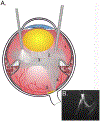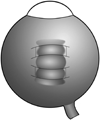A review of treatment for retinopathy of prematurity
- PMID: 31762784
- PMCID: PMC6874220
- DOI: 10.1080/17469899.2019.1596026
A review of treatment for retinopathy of prematurity
Abstract
Introduction: Retinopathy of prematurity (ROP) is a leading cause of childhood blindness worldwide.
Areas covered: Recent methods to identify and manage treatment-warranted vascularly active ROP are recognized and being compared to standard care by laser treatment in prospective large-scale clinical studies. Pharmacologic anti-angiogenic (anti-VEGF) treatment has changed the natural history of vascularly active ROP by reducing stage 3 intravitreal neovascularization and extending physiologic retinal vascularization in many infants. Tractional retinal detachments in stage 4 ROP after treatment with anti-VEGF agents show additional fibrovascular complexity compared to eyes treated with laser only. We review current management and outcomes for vascularly active and fibrovascular retinal detachment in ROP (stages 3, 4, 5 ROP), highlighting the evidence from recent clinical studies. Included are technical details important in surgery for retinal detachment in ROP. Literature searches were employed through PubMed.
Expert opinion: Methods in pediatric imaging, safer pharmacologic treatments, and surgical techniques continue to advance to improve future ROP outcomes.
Keywords: angiogenesis; laser; lens-sparing; retinal detachment; retinopathy of prematurity (ROP); scleral buckle; stage 4 or 5 ROP; surgical outcomes; vascular endothelial growth factor inhibitors (anti-VEGF); vitrectomy.
Conflict of interest statement
Declaration of interest The authors have no relevant affiliations or financial involvement with any organization or entity with a financial interest in or financial conflict with the subject matter or materials discussed in the manuscript. This includes employment, consultancies, honoraria, stock ownership or options, expert testimony, grants or patents received or pending, or royalties.
Figures





Similar articles
-
Retinopathy of Prematurity.2025 Jun 2. In: StatPearls [Internet]. Treasure Island (FL): StatPearls Publishing; 2025 Jan–. 2025 Jun 2. In: StatPearls [Internet]. Treasure Island (FL): StatPearls Publishing; 2025 Jan–. PMID: 32965990 Free Books & Documents.
-
Vitreous levels of stromal cell-derived factor 1 and vascular endothelial growth factor in patients with retinopathy of prematurity.Ophthalmology. 2008 Jun;115(6):1065-1070.e1. doi: 10.1016/j.ophtha.2007.08.050. Epub 2007 Nov 26. Ophthalmology. 2008. PMID: 18031819
-
Current concepts and techniques of vitrectomy for retinopathy of prematurity.Taiwan J Ophthalmol. 2018 Oct-Dec;8(4):216-221. doi: 10.4103/tjo.tjo_102_18. Taiwan J Ophthalmol. 2018. PMID: 30637193 Free PMC article. Review.
-
Combined Vitrectomy and Anti-VEGF Treatment for Stage 4 Retinopathy of Prematurity With Extensive Neovascular Proliferation.J Pediatr Ophthalmol Strabismus. 2020 Jan 1;57(1):61-66. doi: 10.3928/01913913-20191030-01. J Pediatr Ophthalmol Strabismus. 2020. PMID: 31972043
-
A Narrative Review on Managing Retinopathy of Prematurity: Insights Into Pathogenesis, Screening, and Treatment Strategies.Cureus. 2024 Mar 14;16(3):e56168. doi: 10.7759/cureus.56168. eCollection 2024 Mar. Cureus. 2024. PMID: 38618439 Free PMC article. Review.
Cited by
-
Comparison of Single-Treatment Efficacy of Bevacizumab and Ranibizumab for Retinopathy of Prematurity.Children (Basel). 2024 Jul 31;11(8):927. doi: 10.3390/children11080927. Children (Basel). 2024. PMID: 39201864 Free PMC article.
-
Effects of diode laser photocoagulation treatment on ocular biometric parameters in premature infants with retinopathy of prematurity.Int J Ophthalmol. 2021 Feb 18;14(2):277-282. doi: 10.18240/ijo.2021.02.15. eCollection 2021. Int J Ophthalmol. 2021. PMID: 33614458 Free PMC article.
-
Anatomic and Functional Outcomes of Scleral Buckling Surgery for Advanced Retinopathy of Prematurity: A Systematic Review and Proportional Meta-Analysis.Cureus. 2024 Dec 19;16(12):e76000. doi: 10.7759/cureus.76000. eCollection 2024 Dec. Cureus. 2024. PMID: 39835066 Free PMC article. Review.
-
A review on retinopathy of prematurity.Med Hypothesis Discov Innov Ophthalmol. 2025 Feb 1;13(4):201-212. doi: 10.51329/mehdiophthal1511. eCollection 2024 Winter. Med Hypothesis Discov Innov Ophthalmol. 2025. PMID: 40065804 Free PMC article. Review.
-
Alteration of Tear Metabolomics Profiling in Infants With Retinopathy of Prematurity.Invest Ophthalmol Vis Sci. 2025 Jun 2;66(6):61. doi: 10.1167/iovs.66.6.61. Invest Ophthalmol Vis Sci. 2025. PMID: 40540260 Free PMC article.
References
-
- Gilbert C Retinopathy of prematurity: A global perspective of the epidemics, population of babies at risk and implications for control. Early Human Development. 2008. 2/2008;84(2):77–82. - PubMed
-
- Blencowe H, Moxon S, Gilbert C. Update on Blindness Due to Retinopathy of Prematurity Globally and in India. Indian pediatrics. 2016. November 7;53 Suppl 2:S89–s92. PubMed PMID: 27915313; eng. - PubMed
Grants and funding
LinkOut - more resources
Full Text Sources
